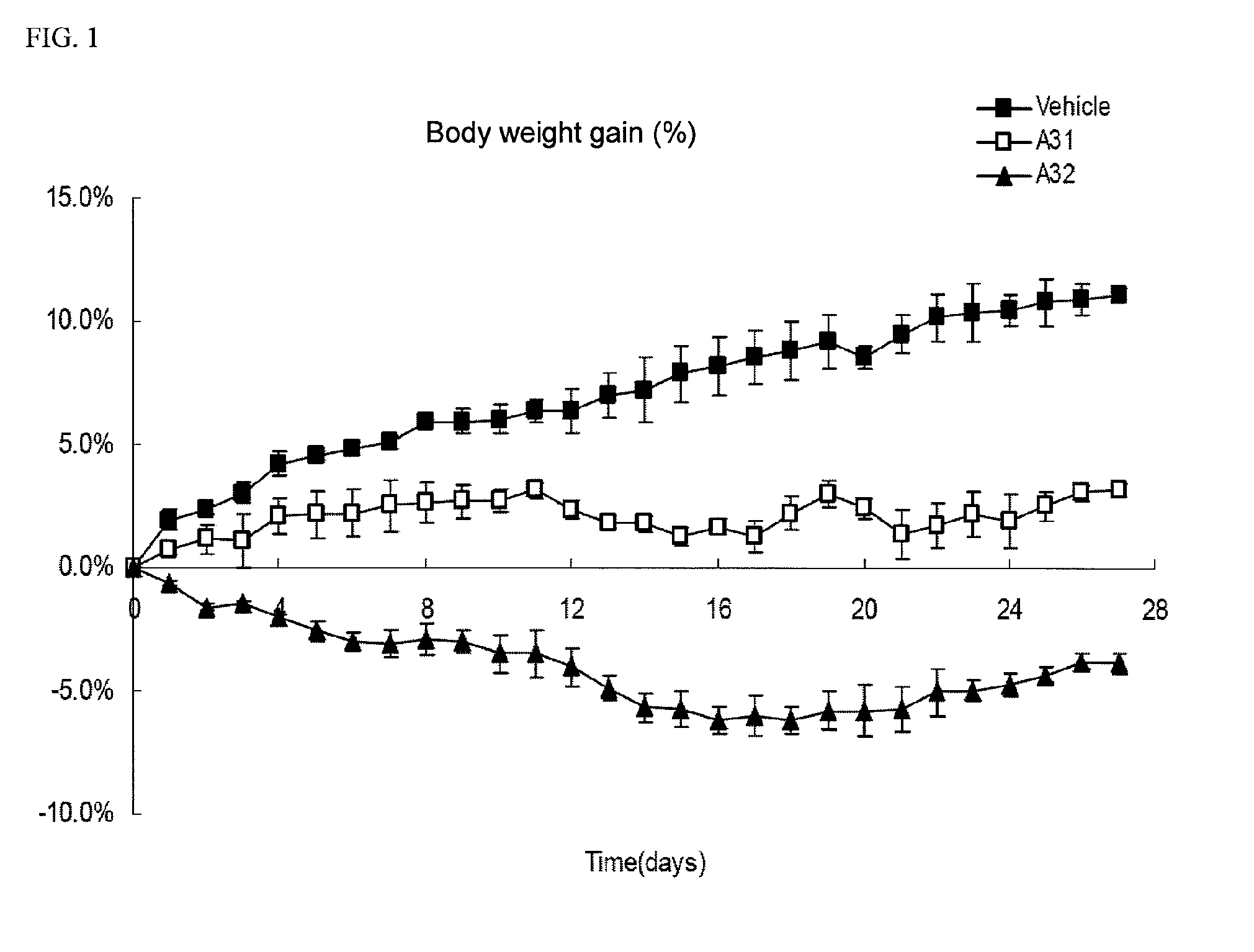Use of prodrug composition containing naphthoquinone-based compound for manufacture of medicament for treatment or prevention of diseases involving metabolic syndrome
a technology of naphthoquinone and prodrug composition, which is applied in the field of use of prodrug composition containing naphthoquinone-based compound for the manufacture of medicaments for the treatment or prevention of metabolic syndrome diseases, can solve the problems of high aqueous solution soluble naphthoquinone compound drugs, inability to treat various diseases resulting from excess energy intake, abnormal fat accumulation, etc., to improve the dissolution rate and in vivo absorption rate, the degree of crystallinity
- Summary
- Abstract
- Description
- Claims
- Application Information
AI Technical Summary
Benefits of technology
Problems solved by technology
Method used
Image
Examples
example 1
Synthesis of 5-acetyloxy-2,2-dimethyl-3,4-dihydro-2H-benzo[h]chromen-6-yl N-(t-butoxycarbonyl)isoleucinate
[0156]
[0157]5 g of zinc powder, 5 g of 2,2-dimethyl-3,4-dihydro-2H-benzo[h]chromene-5,6-dione, 16.5 g of Na2S2O4, 8.1 g of N-(t-butoxycarbonyl)isoleucine, 2.8 mL of triethylamine, 17.5 g of HBTU, and 100 mL of DMF were mixed and stirred at room temperature for 15 hours. 300 mL of EtOAc was added to the reaction mixture. The reaction mixture was filtered and washed with water. The organic extract was dried over Na2SO4 and concentrated under reduced pressure. The resulting residue was dissolved in 40 mL of acetic anhydride, and 4.0 g of zinc powder and 4.53 g of triethylamine were added thereto. The reaction mixture was heated with vigorous stirring at 85□ for 2 hours and then cooled. The solvent was removed under reduced pressure.
[0158]The resulting residue was dissolved in 200 mL of EtOAc and washed with water. The organic extract was dried over Na2SO4 and concentrated under red...
example 2
Synthesis of 5-acetyloxy-2,2-dimethyl-3,4-dihydro-2H-benzo[h]chromen-6-yl Isoleucinate Hydrochloride
[0159]
[0160]5-(acetyloxy)-2,2-dimethyl-3,4-dihydro-2H-benzo[h]chromen-6-yl N-(t-butoxycarbonyl)isoleucinate prepared in Example 2 was dissolved in 1,4-dioxane to which a solution of hydrogen chloride in anhydrous 1,4-dioxane was then added. The reaction mixture was stirred at room temperature for 6 hours and dried under reduced pressure to afford of the title compound (yield: 98%) as a white solid.
example 3
Synthesis of 2-[5-acetyloxy-2,2-dimethyl-3,4-dihydro-2H-benzo[h]chromen-6-yl]1-t-butyl-carboxyl-imidazole-2-ethylamine-2-carboxylate
[0161]
[0162]Analogously to Example 1, the title compound (yield: 29%) was prepared as a white solid, except that a mixture of 4 g of zinc powder, 4 g of 2,2-dimethyl-3,4-dihydro-2H-benzo[h]chromene-5,6-dione, 9.5 g of Na2S2O4, 9.2 g of N-(t-butoxycarbonyl)histidine, 3.7 μL of triethylamine, 15.5 g of HBTU and 90 mL of DMF was used, and acetylation was carried out using 2.4 g of zinc powder, 3.9 g of triethylamine and 50 mL of an acetic anhydride.
PUM
| Property | Measurement | Unit |
|---|---|---|
| particle diameter | aaaaa | aaaaa |
| solubility | aaaaa | aaaaa |
| solubility | aaaaa | aaaaa |
Abstract
Description
Claims
Application Information
 Login to View More
Login to View More - R&D
- Intellectual Property
- Life Sciences
- Materials
- Tech Scout
- Unparalleled Data Quality
- Higher Quality Content
- 60% Fewer Hallucinations
Browse by: Latest US Patents, China's latest patents, Technical Efficacy Thesaurus, Application Domain, Technology Topic, Popular Technical Reports.
© 2025 PatSnap. All rights reserved.Legal|Privacy policy|Modern Slavery Act Transparency Statement|Sitemap|About US| Contact US: help@patsnap.com



